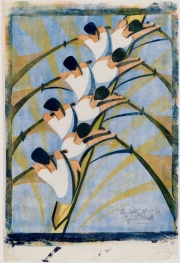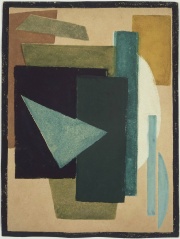Difference between revisions of "Linocut"
(username removed) |
m (Text replace - "== Authority ==" to "== Sources Checked for Data in Record ==") |
||
| (2 intermediate revisions by 2 users not shown) | |||
| Line 2: | Line 2: | ||
== Description == | == Description == | ||
| − | A block print prepared from a design engraved into a piece of [ | + | A block print prepared from a design engraved into a piece of [[linoleum]]. Linocuts, first made in the late 19th century, exhibit a wider variety of patterns than woodcuts since linoleum is much easier to cut than wood. Since the linoleum is smooth and has no directional grain, it's patterns often included flat, uniform color regions. The images were used for works of art on paper as well as printed textiles. The linocut technique was made popular by Pablo Picasso and Henri Matisse in the 1950s. |
== Synonyms and Related Terms == | == Synonyms and Related Terms == | ||
| − | linoleum cut; vinyl cut; vinylcut; linoleumsnede (Ned.); lingravure (Fr.); gravure sur | + | linoleum cut; vinyl cut; vinylcut; linoleumsnede (Ned.); lingravure (Fr.); gravure sur linoléum (Fr.); Linolschnitt (Deut.); linoleografia (It.); grabado en linoleo (Esp.); linoleumtryck (Sven.); linoleumsnitt (Sven.) |
[[File:1991.930-SC28848.jpg|thumb|'''MFA Acc. #:''' 1991.930]] | [[File:1991.930-SC28848.jpg|thumb|'''MFA Acc. #:''' 1991.930]] | ||
| Line 13: | Line 13: | ||
Cut edges are rough. | Cut edges are rough. | ||
| − | == | + | == Sources Checked for Data in Record == |
| − | * | + | * Luis Nadeau, ''Encyclopedia of Printing, Photographic, and Photomechanical Processes'', Atelier, New Brunswick, 1997 Comment: developed in the 20th century |
* ''The Bullfinch Guide to Art History'', Shearer West (ed.), Bullfinch Press, Boston, 1996 Comment: used in 19th century | * ''The Bullfinch Guide to Art History'', Shearer West (ed.), Bullfinch Press, Boston, 1996 Comment: used in 19th century | ||
| − | * | + | * B. Gascoigne, ''How to Identify Prints'', Thames & Hudson, London, 2004 |
| − | * ''Encyclopedia Britannica'', http://www.britannica.com Comment: "linocut." | + | * ''Encyclopedia Britannica'', http://www.britannica.com Comment: "linocut." Encyclopædia Britannica. 2005. Encyclopædia Britannica Premium Service - introduced in early 20th century 3 Feb. 2005 . |
| − | * | + | * Website address 1 Comment: Multilingual Glossary for Art Librarians at http://www.ifla.org/VII/s30/pub/mgl.htm |
* ''The American Heritage Dictionary'' or ''Encarta'', via Microsoft Bookshelf 98, Microsoft Corp., 1998 | * ''The American Heritage Dictionary'' or ''Encarta'', via Microsoft Bookshelf 98, Microsoft Corp., 1998 | ||
Revision as of 07:33, 1 May 2016
Description
A block print prepared from a design engraved into a piece of Linoleum. Linocuts, first made in the late 19th century, exhibit a wider variety of patterns than woodcuts since linoleum is much easier to cut than wood. Since the linoleum is smooth and has no directional grain, it's patterns often included flat, uniform color regions. The images were used for works of art on paper as well as printed textiles. The linocut technique was made popular by Pablo Picasso and Henri Matisse in the 1950s.
Synonyms and Related Terms
linoleum cut; vinyl cut; vinylcut; linoleumsnede (Ned.); lingravure (Fr.); gravure sur linoléum (Fr.); Linolschnitt (Deut.); linoleografia (It.); grabado en linoleo (Esp.); linoleumtryck (Sven.); linoleumsnitt (Sven.)
Other Properties
Cut edges are rough.
Sources Checked for Data in Record
- Luis Nadeau, Encyclopedia of Printing, Photographic, and Photomechanical Processes, Atelier, New Brunswick, 1997 Comment: developed in the 20th century
- The Bullfinch Guide to Art History, Shearer West (ed.), Bullfinch Press, Boston, 1996 Comment: used in 19th century
- B. Gascoigne, How to Identify Prints, Thames & Hudson, London, 2004
- Encyclopedia Britannica, http://www.britannica.com Comment: "linocut." Encyclopædia Britannica. 2005. Encyclopædia Britannica Premium Service - introduced in early 20th century 3 Feb. 2005 .
- Website address 1 Comment: Multilingual Glossary for Art Librarians at http://www.ifla.org/VII/s30/pub/mgl.htm
- The American Heritage Dictionary or Encarta, via Microsoft Bookshelf 98, Microsoft Corp., 1998

